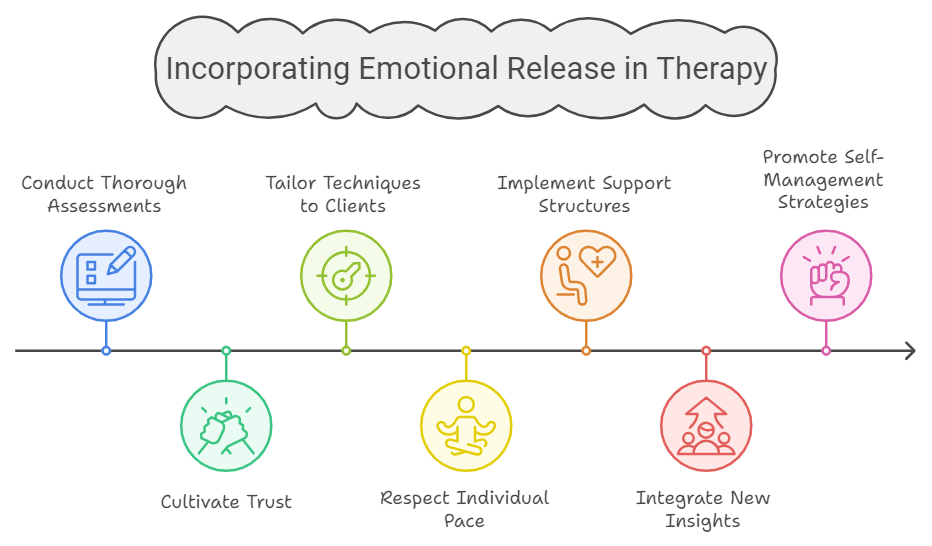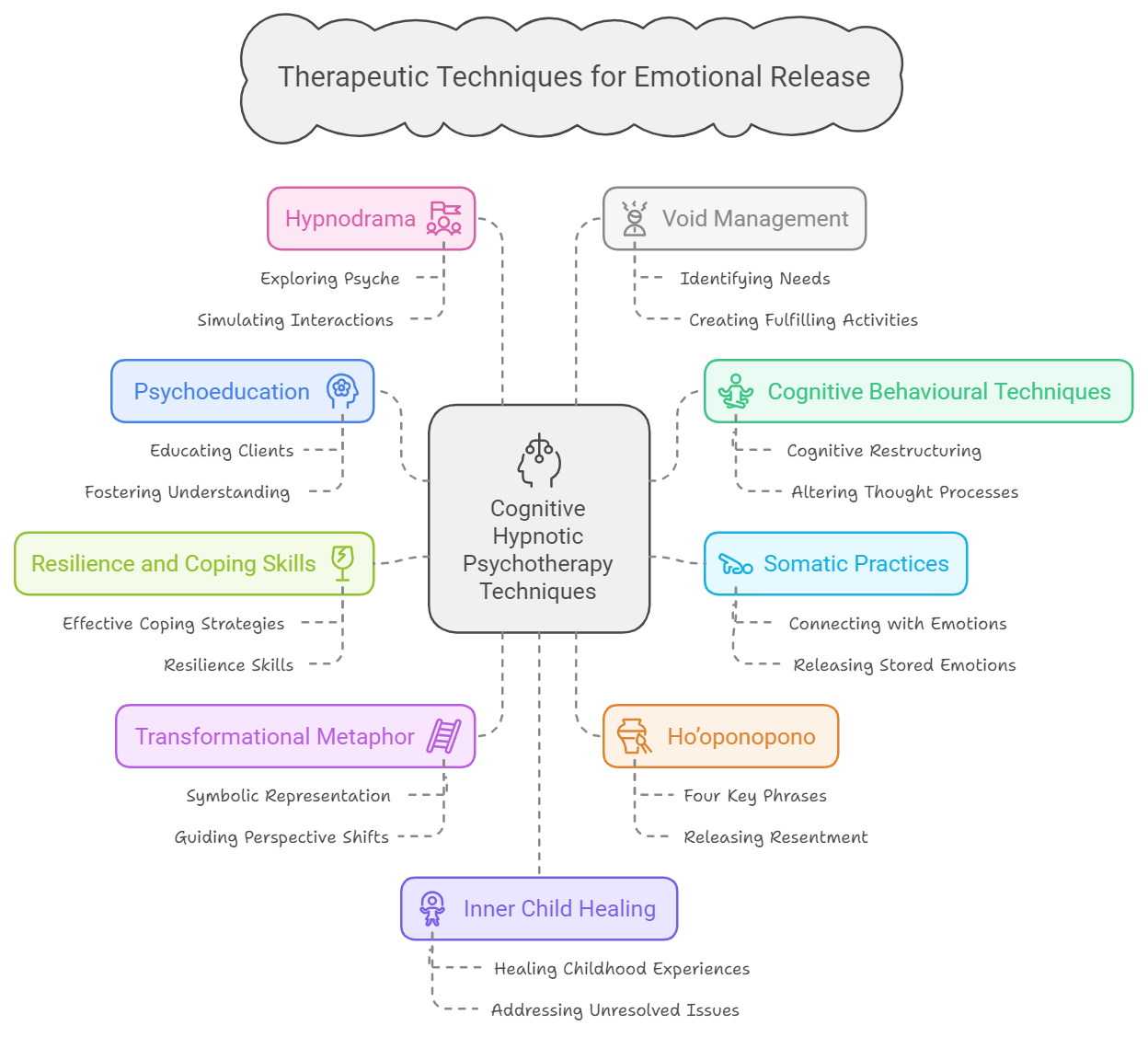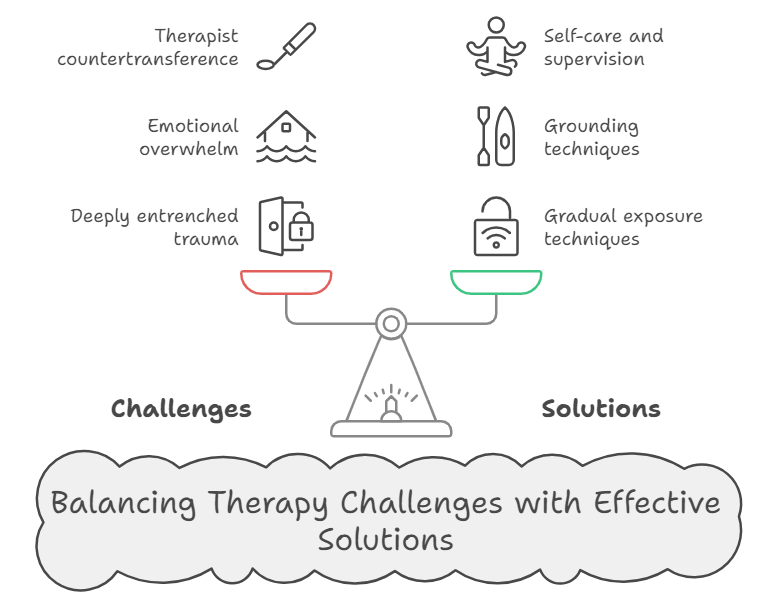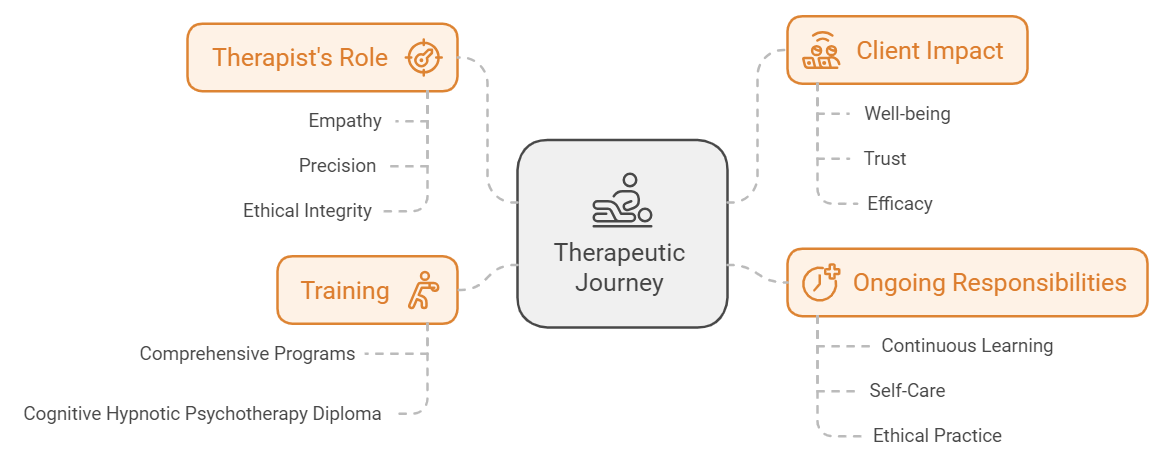In the therapeutic journey, delving into the deep-seated emotions and traumas that lie beneath the surface of conscious awareness is often essential. The competency of Releasing and Replacing Suppressed Emotions and Trauma is crucial for practitioners to guide clients through this delicate process.
This competency involves uncovering suppressed emotions, facilitating their release, and assisting clients in replacing these with healthier emotional responses. Successfully navigating this transformative work requires a blend of sensitivity, skill, and advanced therapeutic knowledge.
This article will explore the intricacies of this competency and provide insights into practical techniques and ethical considerations essential for facilitating emotional and traumatic healing.
Understanding ‘Releasing and Replacing Emotions’

Mastering the ability to release and replace suppressed emotions and trauma involves several layered steps. Practitioners need to be adept at the following:
- Recognizing Suppression: Identifying signs that a client may be consciously or unconsciously suppressing emotions or trauma. These signs can include physiological responses, avoidance behaviours, and specific speech patterns.
- Creating Safety: Establishing a secure and supportive environment where clients feel safe to confront and process difficult emotions. This foundational step is crucial for effective therapeutic intervention.
- Facilitating Release: Employing therapeutic techniques to help clients express and release pent-up emotions that may have been held in their psyche for extended periods. Techniques may include talk therapy, expressive arts, or somatic practices.
- Developing New Emotional Responses: Assisting clients in cultivating healthier emotional reactions to replace those stemming from past trauma. This process should be tailored to the individual’s unique healing journey.
- Integrating Healing: Ensuring that new, healthier responses become part of the client’s broader repertoire of coping strategies. This integration is vital for sustaining long-term wellbeing.
Understanding the Limitations of Catharsis
While emotional release can be cathartic, it is often insufficient for long-term healing and growth. Simply experiencing an emotional release does not necessarily lead to sustainable change or resolution of underlying issues.
Clients may temporarily feel relief after expressing suppressed emotions, but without further exploration and processing, these emotions may resurface, potentially leading to repeated cycles of distress.
Application in Practice
Applying the competency of ‘Releasing and Replacing Emotions’ within therapeutic sessions is a nuanced process that requires tact, patience, and expertise. Here’s how practitioners can effectively incorporate this vital skill into their work.

- Conduct Thorough Assessments: Approach the initial assessment with an open, nonjudgmental stance, sensitively cataloging signs of suppressed emotions or trauma.
- Cultivate Trust: Develop a deep sense of trust with clients. Establishing trust is essential for clients to feel comfortable engaging in the vulnerable work of releasing suppressed emotions.
- Tailor Techniques to Clients: Select and apply therapeutic techniques best suited to each client’s specific situation and readiness, whether it’s narrative therapy, body-oriented approaches, or creative arts therapies.
- Respect Individual Pace: Respect each client’s emotional journey and avoid rushing the process of emotional release. Ensure interventions are timed appropriately.
- Implement Support Structures: Suggest and implement support structures, such as mindfulness practices or support groups, to provide clients with additional tools for managing the release of suppressed emotions.
- Integrate New Insights: Incorporate new emotional insights into the overall therapy goals. Continuously revisit and reinforce these as part of the ongoing therapeutic dialogue.
- Promote Self-Management Strategies: Guide clients towards self-management strategies that enable them to maintain and continue the progress achieved in sessions.
Bringing this approach into each session can significantly enhance a client’s self-awareness and promote healing from past traumas, leading to more fulfilling lives.
Cognitive Hypnotic Psychotherapy Approach to ‘Releasing and Replacing Emotions’
The Cognitive Hypnotic Psychotherapy (CHP) framework integrates a spectrum of techniques to facilitate the delicate process of releasing and replacing suppressed emotions and trauma. Here’s a detailed overview of how CHP can be effectively applied in therapeutic settings.

- Psychoeducation
CHP stresses the importance of educating clients about the nature of emotions and trauma, fostering an understanding that often sparks the initial steps towards healing. - Cognitive Behavioural Techniques
Cognitive restructuring strategies are employed to alter maladaptive thought processes that maintain emotional suppression. - Somatic Practices
Incorporating body-focused practices helps clients connect with and release emotions that may be stored physically. - Resilience and Coping Skills
CHP ensures that clients are equipped with effective coping strategies and resilience skills to manage emotional fluctuations during and after release. - Transformational Metaphor
This type of metaphor facilitates deep change by symbolically representing the transformation process within the narrative itself—ideal for guiding clients through significant shifts in perspective or behaviour. - Ho’oponopono
A Hawaiian practice of reconciliation and forgiveness involving four key phrases: I’m sorry, Please forgive me, Thank you, and I love you. Therapists use this technique to help clients release resentment, guilt, or negativity towards others or themselves. - Hypnodrama
Combines hypnosis with role-playing activities to explore different aspects of a client’s psyche or simulate interactions with others in a safe environment. It can be particularly effective for understanding interpersonal dynamics and preparing for challenging conversations. - Void Management
This strategy helps individuals cope with feelings of emptiness by identifying underlying needs and creating fulfilling activities or thoughts to fill perceived voids in life—useful for those who feel an unexplained sense of lack despite having no apparent reason for it. - Inner Child Healing
This technique involves connecting with and healing the ‘inner child’—the part of oneself that holds onto childhood experiences and emotions. It’s used when clients need to address unresolved issues from their past that continue to affect their present behaviour and emotional well-being. - NLP Re-imprinting
This technique involves changing negative memories by altering the way they are stored in the mind (re-imprinting) so that they no longer have a detrimental effect on current behaviour—effective for transforming traumatic memories into empowering ones. - NLP Fast Phobia Cure
An NLP method designed specifically to eliminate phobias quickly by dissociating the individual from the fear-inducing stimulus through visualization exercises—used when clients want rapid relief from specific phobias. - Emotional Empowerment Technique: A holistic approach combining elements like tapping (EFT), affirmations, breathwork etc., aimed at releasing trapped emotions within the body while fostering positive feelings & resilience – ideal if client struggles managing intense emotional responses
- Self Validation & Integration Therapy: Focuses primarily around helping individuals acknowledge validate different parts themselves integrating these aspects harmoniously whole being rather than fragmented pieces- especially useful those dealing internal conflicts low self-esteem/self-worth issues
- Integration of Therapeutic Models:
An integrative approach combines these techniques with traditional therapeutic models, creating a comprehensive method for addressing suppressed emotions and trauma.
The Cognitive Hypnotic Psychotherapy framework’s unique methodology empowers therapists to guide clients through the release and replacement of suppressed emotions and trauma safely and effectively, paving the way for lasting change and improved mental well-being.
Overcoming Challenges and Pitfalls

When working on releasing and replacing emotions, therapists may encounter several challenges. Understanding these obstacles and having effective strategies in place are crucial for facilitating a smooth healing process. Here are solutions to some common difficulties.
Deeply Entrenched Trauma
Challenge: Trauma can be deeply embedded and resistant to change.
Solution: Utilize gradual exposure techniques and prioritize building resilience alongside exploring traumatic memories to prevent retraumatization. Gradually introducing the trauma allows clients to process it in manageable segments, reducing the risk of being overwhelmed.
Client Emotional Overwhelm
Challenge: The emotional release can sometimes lead to overwhelm.
Solution: Teach grounding and self-soothing techniques beforehand and pace the sessions to match the client’s capacity to process emotions. Techniques such as deep breathing, progressive muscle relaxation, and mindfulness can help clients stay grounded during intense emotional work.
Therapist Countertransference
Challenge: Therapists may find their emotions triggered by the client’s experiences.
Solution: Engage in regular self-care and supervision to manage personal reactions and maintain a clear focus on the client’s needs. Supervision and peer support can provide valuable perspectives and strategies for handling countertransference.
Client Reluctance
Challenge: Some clients may be reluctant to engage with painful memories or emotions.
Solution: Respect the client’s pace and readiness, providing reassurance of safety and control over the therapeutic process. Emphasize the importance of autonomy and create a collaborative environment where the client feels empowered to engage when ready.
Measuring Progress
Challenge: Tracking improvements can be complex when dealing with abstract emotional changes.
Solution: Use qualitative measures, such as client self-reports and observable behavioural changes, to assess progress. Regular check-ins and reflective discussions can help both the therapist and client recognize subtle shifts and improvements.
Maintaining a Strengths-Based Approach
Challenge: Ensure the therapeutic focus isn’t solely on pathology.
Solution: Consistently highlight and cultivate the client’s strengths, resources, and past successes throughout the therapy. Encourage clients to draw on their inherent strengths and resilience, reinforcing a positive self-image and fostering empowerment.
Conclusion
The therapeutic journey to release and replace suppressed emotions and trauma is both delicate and pivotal. It requires therapists to navigate the depths of human experience with empathy, precision, and ethical integrity. Mastering the competency of guiding clients through this transformative process is a testament to a practitioner’s dedication and skill in facilitating true healing.
Training, such as that provided by comprehensive programs like the Cognitive Hypnotic Psychotherapy Diploma, equips professionals with the necessary knowledge and tools to approach this work responsibly. These skills not only ensure client well-being but also fortify the trust and efficacy at the heart of the therapeutic relationship.

Successfully addressing suppressed emotions and trauma is an endeavor that can profoundly change lives. It underscores the immense responsibility and privilege that comes with the role of therapist, highlighting the importance of continuous learning, self-care, and a deep commitment to ethical practice.

